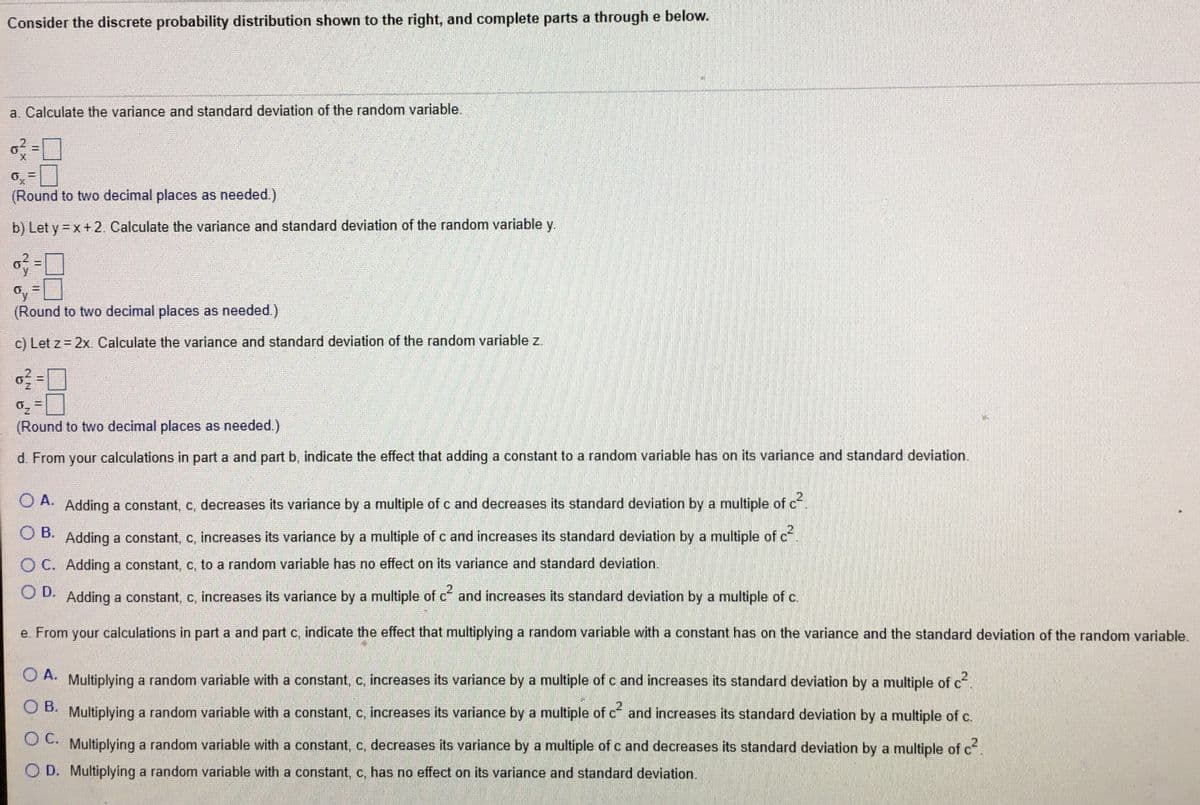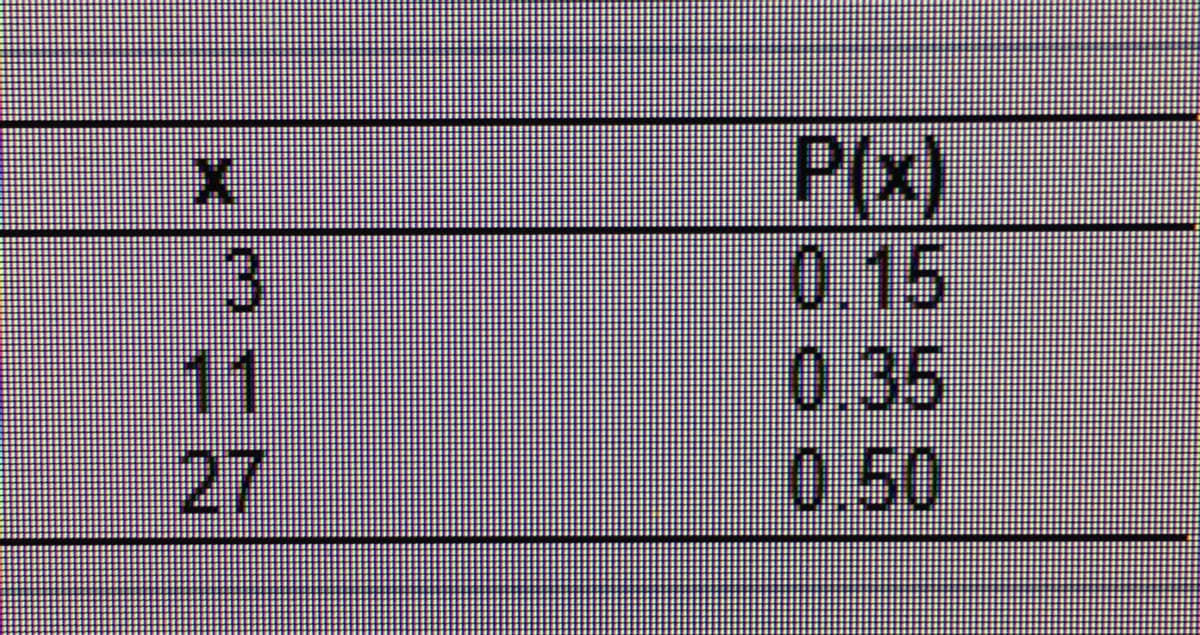a. Calculate the variance and standard deviation of the random variable. 6, = (Round to two decimal places as needed.) b) Let y = x+2. Calculate the variance and standard deviation of the random variable y. oy (Round to two decimal places as needed.) c) Let z= 2x. Calculate the variance and standard deviation of the random variable z. (Round to two decimal places as needed.) d. From your calculations in part a and part b, indicate the effect that adding a constant to a random variable has on its variance and standard deviation. OA. Adding a constant, c, decreases its variance by a multiple of c and decreases its standard deviation by a multiple of c. O B. Adding a constant, c, increases its variance by a multiple of c and increases its standard deviation by a multiple of c O C. Adding a constant, c, to a random variable has no effect on its variance and standard deviation.
a. Calculate the variance and standard deviation of the random variable. 6, = (Round to two decimal places as needed.) b) Let y = x+2. Calculate the variance and standard deviation of the random variable y. oy (Round to two decimal places as needed.) c) Let z= 2x. Calculate the variance and standard deviation of the random variable z. (Round to two decimal places as needed.) d. From your calculations in part a and part b, indicate the effect that adding a constant to a random variable has on its variance and standard deviation. OA. Adding a constant, c, decreases its variance by a multiple of c and decreases its standard deviation by a multiple of c. O B. Adding a constant, c, increases its variance by a multiple of c and increases its standard deviation by a multiple of c O C. Adding a constant, c, to a random variable has no effect on its variance and standard deviation.
MATLAB: An Introduction with Applications
6th Edition
ISBN:9781119256830
Author:Amos Gilat
Publisher:Amos Gilat
Chapter1: Starting With Matlab
Section: Chapter Questions
Problem 1P
Related questions
Topic Video
Question
100%
Data is in one image and question in the other. Thanks! :)

Transcribed Image Text:Consider the discrete probability distribution shown to the right, and complete parts a through e below.
a. Calculate the variance and standard deviation of the random variable.
(Round to two decimal places as needed.)
b) Let y = x +2. Calculate the variance and standard deviation of the random variable y.
%3D
(Round to two decimal places as needed.)
c) Let z = 2x. Calculate the variance and standard deviation of the random variable z.
%3D
(Round to two decimal places as needed.)
d. From your calculations in part a and part b, indicate the effect that adding a constant to a random variable has on its variance and standard deviation.
O A.
Adding a constant, c, decreases its variance by a multiple of c and decreases its standard deviation by a multiple of c
O B.
Adding a constant, c, increases its variance by a multiple ofc and increases its standard deviation by a multiple of cf
O C. Adding a constant, c, to a random variable has no effect on its variance and standard deviation.
O D. Adding a constant, c, increases its variance by a multiple of c and increases its standard deviation by a multiple of c.
e. From your calculations in part a and part c, indicate the effect that multiplying a random variable with a constant has on the variance and the standard deviation of the random variable.
O A. Multiplying a random variable with a constant, c, increases its variance by a multiple of c and increases its standard deviation by a multiple of c
O B. Multiplying a random variable with a constant, c, increases its variance by a multiple of c and increases its standard deviation by a multiple of c.
O C.
Multiplying a random variable with a constant, c, decreases its variance by a multiple of c and decreases its standard deviation by a multiple of c.
O D. Multiplying a random variable with a constant, c, has no effect on its variance and standard deviation.

Transcribed Image Text:3
11
27
P(x)
0.15
0.35
0.50
Expert Solution
This question has been solved!
Explore an expertly crafted, step-by-step solution for a thorough understanding of key concepts.
This is a popular solution!
Trending now
This is a popular solution!
Step by step
Solved in 3 steps with 5 images

Knowledge Booster
Learn more about
Need a deep-dive on the concept behind this application? Look no further. Learn more about this topic, statistics and related others by exploring similar questions and additional content below.Recommended textbooks for you

MATLAB: An Introduction with Applications
Statistics
ISBN:
9781119256830
Author:
Amos Gilat
Publisher:
John Wiley & Sons Inc

Probability and Statistics for Engineering and th…
Statistics
ISBN:
9781305251809
Author:
Jay L. Devore
Publisher:
Cengage Learning

Statistics for The Behavioral Sciences (MindTap C…
Statistics
ISBN:
9781305504912
Author:
Frederick J Gravetter, Larry B. Wallnau
Publisher:
Cengage Learning

MATLAB: An Introduction with Applications
Statistics
ISBN:
9781119256830
Author:
Amos Gilat
Publisher:
John Wiley & Sons Inc

Probability and Statistics for Engineering and th…
Statistics
ISBN:
9781305251809
Author:
Jay L. Devore
Publisher:
Cengage Learning

Statistics for The Behavioral Sciences (MindTap C…
Statistics
ISBN:
9781305504912
Author:
Frederick J Gravetter, Larry B. Wallnau
Publisher:
Cengage Learning

Elementary Statistics: Picturing the World (7th E…
Statistics
ISBN:
9780134683416
Author:
Ron Larson, Betsy Farber
Publisher:
PEARSON

The Basic Practice of Statistics
Statistics
ISBN:
9781319042578
Author:
David S. Moore, William I. Notz, Michael A. Fligner
Publisher:
W. H. Freeman

Introduction to the Practice of Statistics
Statistics
ISBN:
9781319013387
Author:
David S. Moore, George P. McCabe, Bruce A. Craig
Publisher:
W. H. Freeman